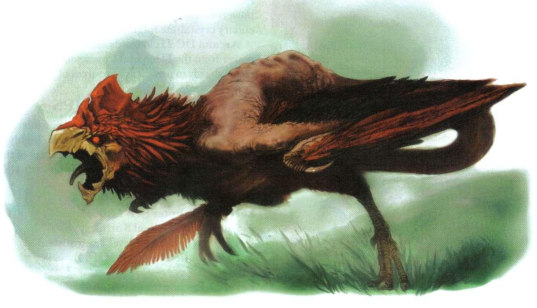Let's Read the 4e Monster Manual 2: Cockatrice

This article is part of a series! Click here to see the other entries.
As far as I know both cockatrices and basilisks are based on the same vague lump of medieval folklore about an animal that can turn you to stone. The exact name, description and proportion of snake/lizard/chicken traits this animal has varies in each specific story. D&D, of course, turned each possible name for the same thing into a totally different monster. They’ve been in the game since at least the days of BECMI.
The Lore
Cockatrices are bird-like monsters whose bite can turn a victim to stone. Unlike a lot of other deadly creatures, though, they don’t actually seem to be predators. Their petrification powers are a defense mechanism, which they will use while trying to run away from whatever enemy threatens them. So yeah, you could say cockatrices are a bit chicken.
Still, cockatrice lairs tend to have the little statue gardens common to petrifying monsters, all likely made from predators who thought they could handle it or from innocent creatures who had no idea whose lawn they were stepping on. I imagine careful adventurers can just avoid the area entirely if they see the statues, though there are reasons they would seek it out instead: the freshly plucked feathers of a cockatrice can be used to brew a potion that undoes petrification if applied within 24 hours. A single dose requires a whole cockatrice’s worth of feathers, which in turn likely requires killing the beast.
Cockatrices are themselves immune to petrification, which makes them good pets for medusas. The book also says other reptilians, like lizardfolk and yuan-ti, also make use of them. They’re definitely easier to handle than a basilisk.
The Numbers
We only get a single stat block here, so let’s get right to it.
Cockatrice
This is a Small Natural Beast and a Level 5 Skirmisher with 63 HP and low-light vision. It’s immune to petrification as discussed earlier, and has a ground speed of 4 and a flight speed of 6 (clumsy). As a reminder, the Clumsy keyword means the creature has a -4 to attacks when using that movement mode.
The cockatrice’s basic attack is its bite, which is kinda weak but triggers a secondary attack vs. Fortitude. A hit there does no damage and slows the victim (save ends). This worsens to Immobilized on the first failed save, and to “permanent until cured” petrification on the second.
If an enemy moves adjacent to the cockatrice it can use Buffeting Wings (recharge 4-6) as an interrupt, which allows it to bite the triggering enemy and shift 3 squares.
Sample Encounters and Final Impressions
Given their low level, cockatrices are likely to be the first petrifying monsters a party encounters. They’re simple, but their main attack is scary enough to make up for that. They could be made into higher-level threats if, in addition to leveling them up, you made them more mobile and gave them an extra special attack.
The sample encounter is Level 5: 2 cockatrices and a trio of lizardfolk using them as attack animals.